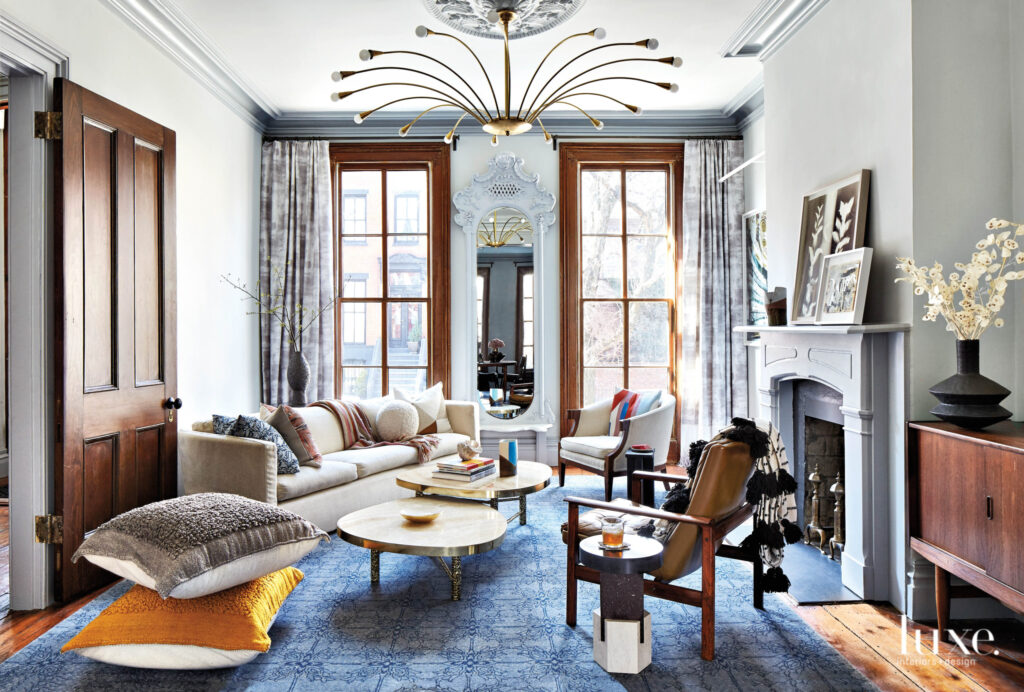Family-Friendly Funk Imbues This Historic Brooklyn Townhouse
Family-Friendly Funk Imbues
Family-Friendly Funk Imbues This Historic Brooklyn Townhouse

Family-Friendly Funk Imbues This Historic Brooklyn Townhouse
Residents of Brooklyn’s leafy Fort Greene enclave for more than a decade, husbands Glenn Hill and Peter Rider enjoyed the sort of tight-knit community commonly associated with small-town life, greeting neighbors by first name, walking to the nearby park and arranging playdates for their three children.
When one neighbor heard through the grapevine that they were looking to buy, he gave them first dibs on the wood-framed 1854 townhouse he had lovingly cared for and called home since the 1980s. “It had only been in two families for the past 100 years,” Peter shares, adding that the former owner bought it from a woman who had lived there since 1918.
While well-maintained, the landmark-status property would need quite a bit of modernizing to suit the family’s needs. So before purchasing, they asked close friend and interior designer Elena Frampton to walk through and imagine the prospects. Frampton was equally smitten: “We loved the old flavor of the house, but it needed updating,” she recalls. “That tightrope of what to keep and what to change was really key to the project.” A hypersensitive approach to balancing old with new would guide the renovation the trio embarked upon alongside architect Bryan Min and general contractor Brian Arkison.
Beyond old with new, the interior designer sought to balance warmth with coolness—a dichotomy achieved by employing a gray and blue base palette to temper the rich, exposed wood architectural elements throughout. Pale gray walls and a painterly cobalt stair runner establish the color story in the entry hall, which gives way to the grand living room. There, a tone-on-tone blue rug anchors neutral furnishings arranged in an informal, asymmetrical layout. Adding further interest to the serene scheme, Frampton designed a vibrant art concept, mingling new pieces—including a Jack Youngerman diptych and Andrew Moore photograph flanking the fireplace—with her clients’ collection of flea market finds, freshly framed. “The art is a lead character,” Frampton notes. “It’s a mix of mediums and comes together in a very interesting, personal way.
The pairing of cool hues and warm woods continues into the adjacent dining room and extends on to the renovated galley kitchen, where a blue-green glazed-brick floor tile arranged in a herringbone pattern plays off custom oak cabinetry. “The kitchen was really like a boat-building exercise,” Frampton adds, noting that the cabinetry reaches the ceiling to take advantage of every square inch of storage.
But while utility and kid-friendliness distinguish the family home, the second-floor master suite, which includes a bedroom, a bathroom accessed via a custom walnut dressing room and a “gentleman’s lounge,” is a dreamy retreat all for the grown-ups. “That’s the space where we said, ‘Let’s have some fun,’” Frampton notes of the latter. A wallpaper depicting flowers and tropical birds and midcentury furnishings re-covered in menswear textiles suggest so much. “Peter is drawn to granny chic. Glenn is more Brooklyn nautical,” Frampton shares, to which Peter adds, “Elena knows what each of our aesthetics are, finds the overlap between them and pushes us to be bolder.”
And of course, enveloping the interiors are the historic bones Min and Arkison restored and celebrated. In addition to collaborating with the Landmarks Preservation Commission on architectural changes—the most prolific of which being a new skylight above the stairwell—Min took choice restorations into his own hands. For example, he conceived a missing railing balustrade by piecing together several salvaged ones from a lumber yard. And to make the original floors sing, he carefully replaced discolored filler between the planks with new fill, faux finishing it to match the wood. “It needed a more finessed touch rather than an off-the-shelf solution,” the architect notes.
Arkison’s role was equally dynamic. His millwork shop fabricated the bespoke cabinetry throughout the home, and among many discreet yet impactful updates, he replaced old radiators with streamlined ones, reappointed original doors, baseboards and trim and added central air conditioning with concealed ductwork as to not call attention to the renovation. “Being authentic is important in an old town house,” says Arkison.
Indeed, authenticity may be this home’s greatest qualifier. “There’s so much newness in New York, and that’s one of the great things about the city, but I also just love the specific sense of time and continuity that you get from living in an older house that you know the direct lineage of,” Peter says. “That’s rare in New York.”




